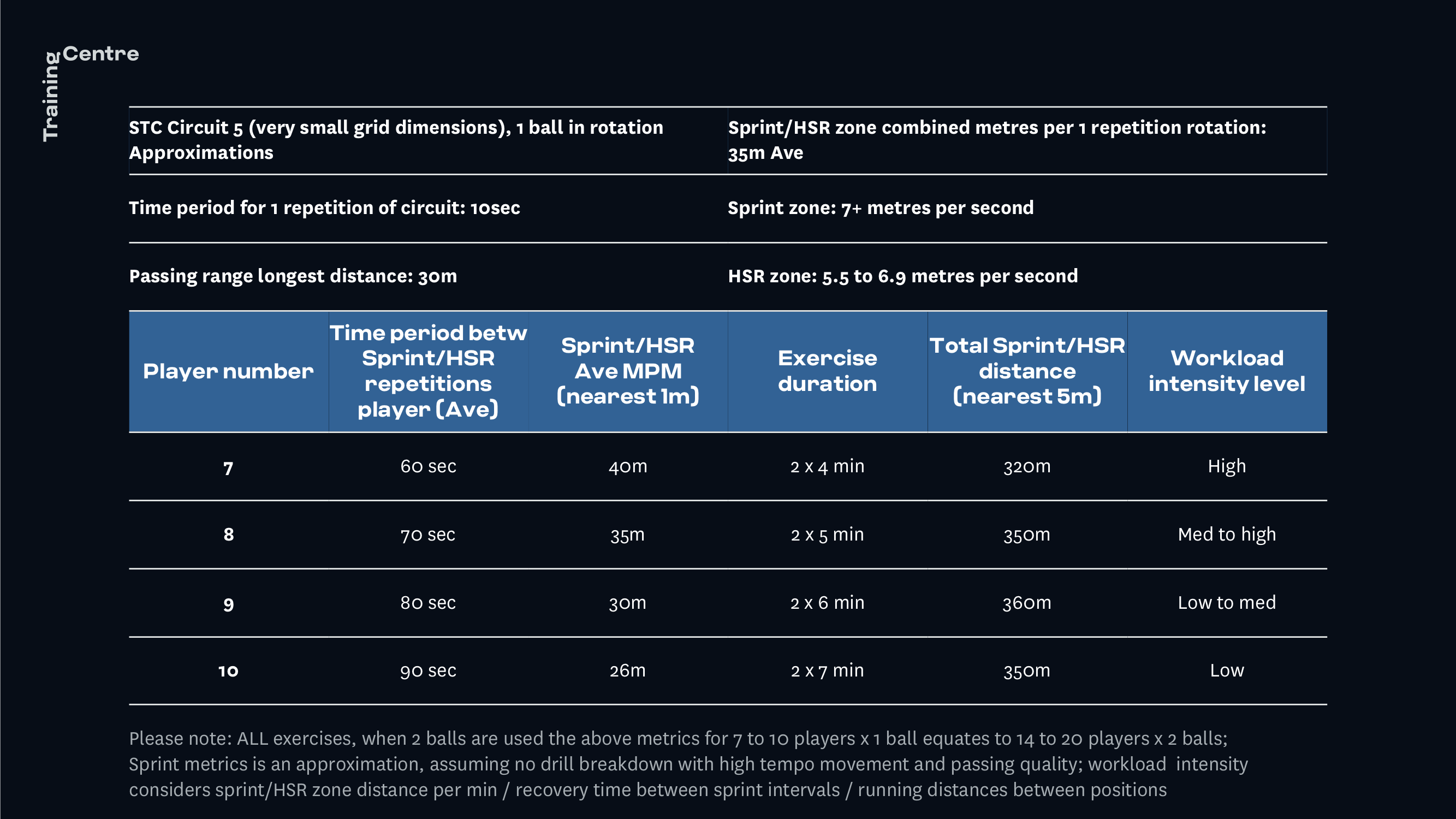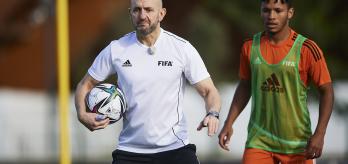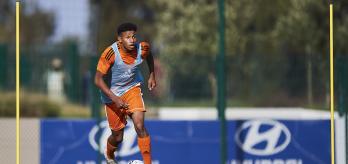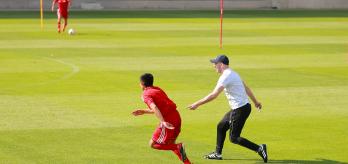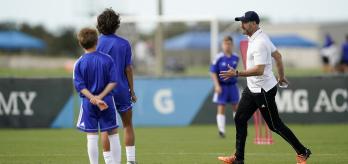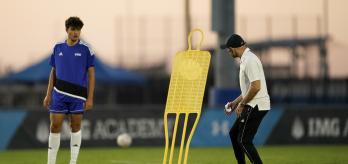The overall goal is to offer a basic training methodology that promotes functional speed development.
A central element of this training method is the combination of tempo, technique and speed, along with technical coordination and passing quality. The circuit 5 drills target these functional qualities with simulations of various attacking combinations that require unity between three to four players. In addition, efficiency of movement, the technical balance of two-footedness and good footballing habits are all priorities within each drill.
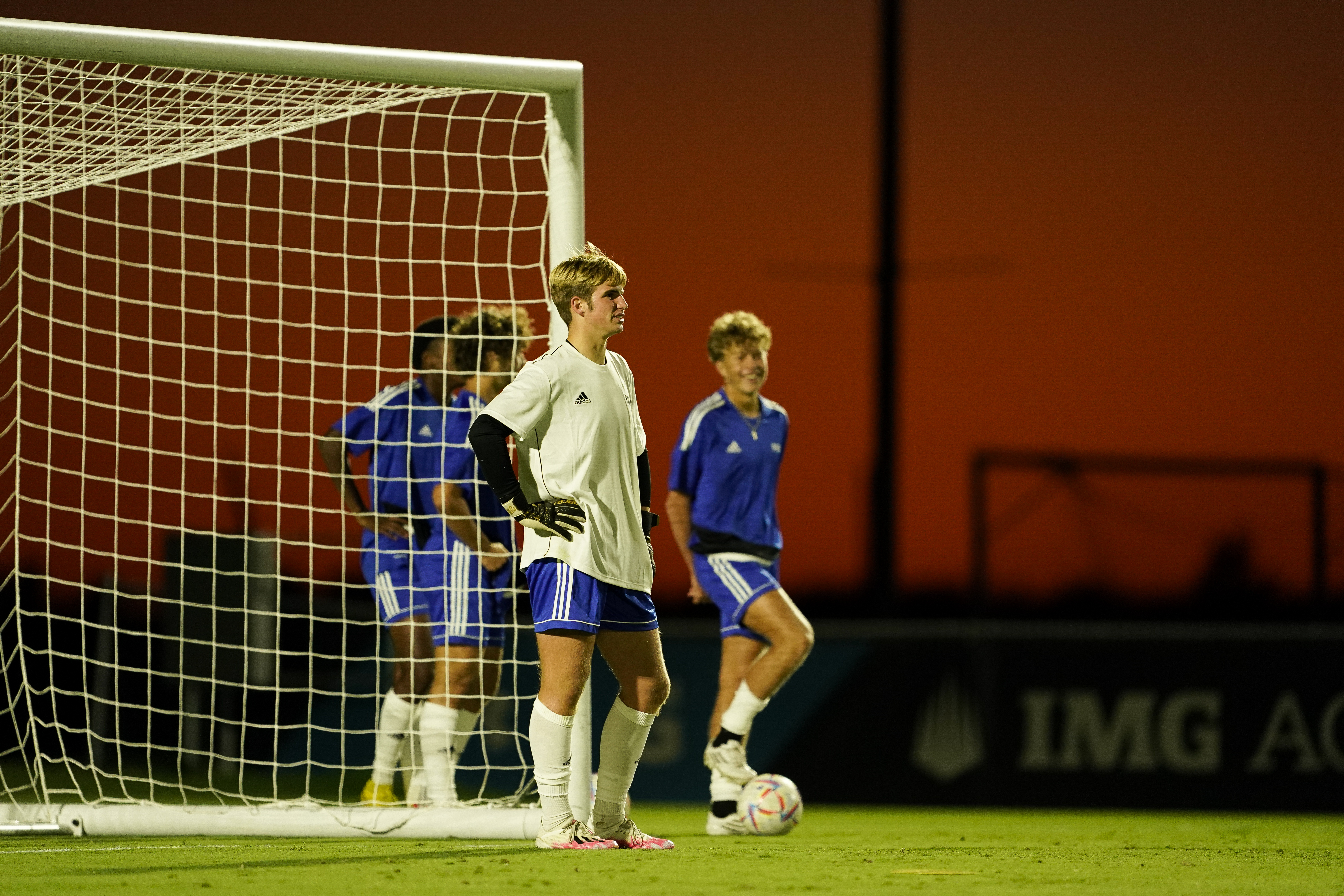
All of the circuit 5 drills include finishing on goal, which enhances player enjoyment and the technical functionality aspect of the circuit. A reoccurring theme across STC circuit 5 is on playing the ball out wide to one side, before combining through the middle and switching to the opposite side to finish on goal. Two of the drills feature an added functionality that involves two players simultaneously combining technically at high speed, with one player running in behind to play a cross to a team-mate who comes in at speed from the opposite side. In addition, simplicity of movement is also a key feature within the circuit drills, with a curved diagonal ball, played from out wide, slotted into the space in behind for the player breaking through the midline to bear down on the goalkeeper from a central position.
Circuit 5 features four grid sizes, ranging from very small to large, that reflect the sprint and high-speed running (HSR) distances and passing ranges involved in the drills. For the purposes of this article, the very small grid, which is an appropriate size for the U 15 boys performing the drills, has been chosen. The very small grid places greater emphasis on technical tempo, timing of acceleration and technical quality, and less on the absolute speed distance covered. If higher overall speed metrics are an objective pursued by a coach, the next grid size (small grid) is more suitable for players in this age group.
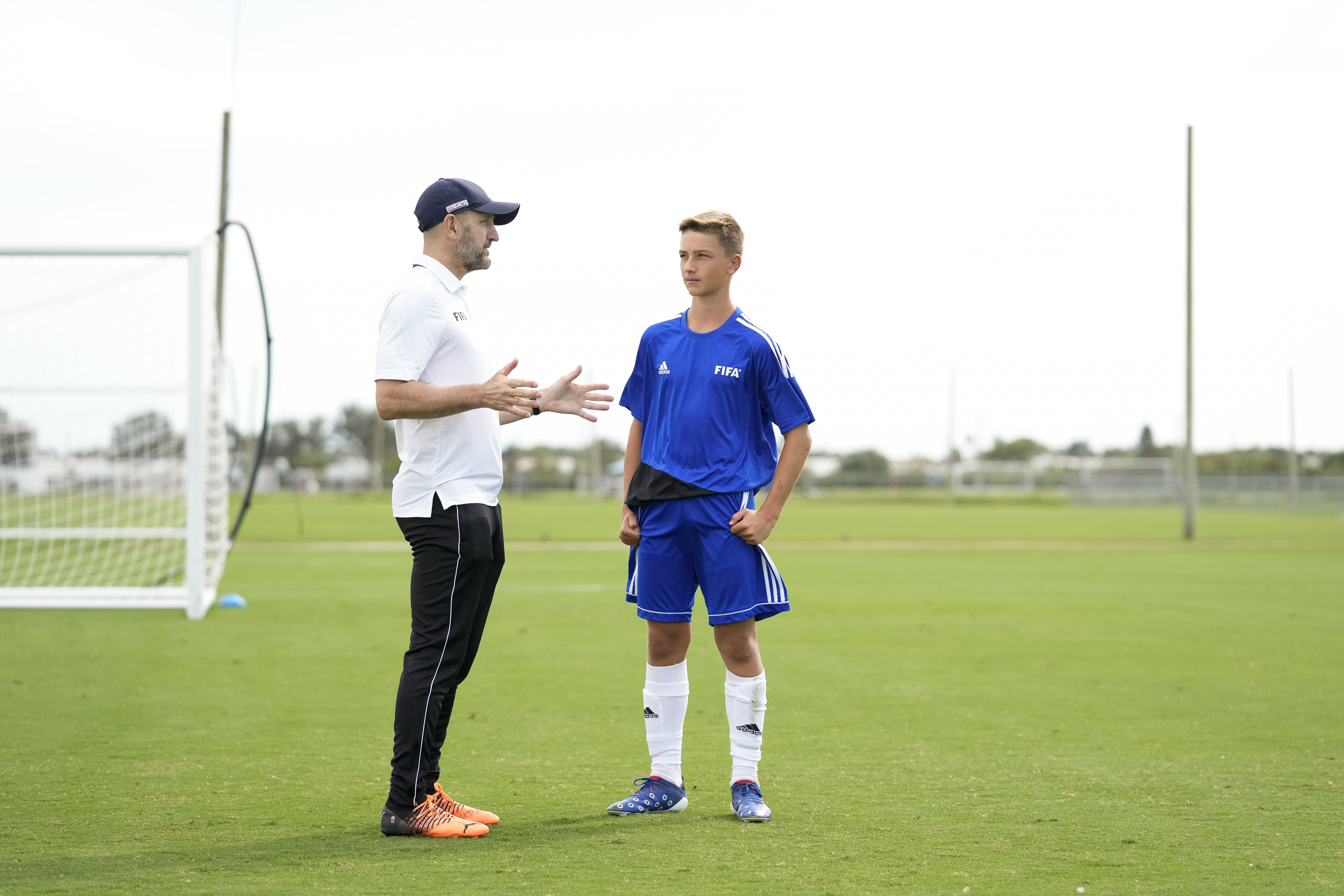
For players in higher age groups, i.e. 16 and over, the smaller grids are ideal for lighter training days in which the overall aim is not focused so heavily on speed metrics. For higher speed metric loading, the medium to larger grids are ideal to attain the required speed distances.
A table featuring the speed metrics and workload intensity is provided at the end of each session plan. It offers approximate figures regarding the distance covered in the sprint/HSR zones for two sets of a drill and information on the intensity of all the exercises relative to the player numbers. A table detailing the player starting positions is also provided for all drills to ensure that all players (between five and ten with one ball; and ten to 16 players with two balls) take up the correct starting position.
Set-up for all drills
-new.jpg)
- Lay out a 55x30m grid using 2 goals and 2 mannequins (a and b).
- Mark out a 20x25m inner grid using 4 mannequins (c and d).
- The distance between the outer edge of the inner grid and the goals should be 17.5m (e).
- Create two 6-metre-wide gates (g) using mannequins, positioned 10m (f) either side from the midpoint of the grid.
- Set 4 flat discs/cones around the centre mark, as displayed in the graphic above, to form two 6 metre wide gates.
- Place a flat disc/cone beyond each corner of the inner grid (h), positioned 5m beyond the outer mannequins (d) and level with the widest mannequins (b).
- If no mannequins are available, a mixture of poles, cones or flat discs may be used instead.
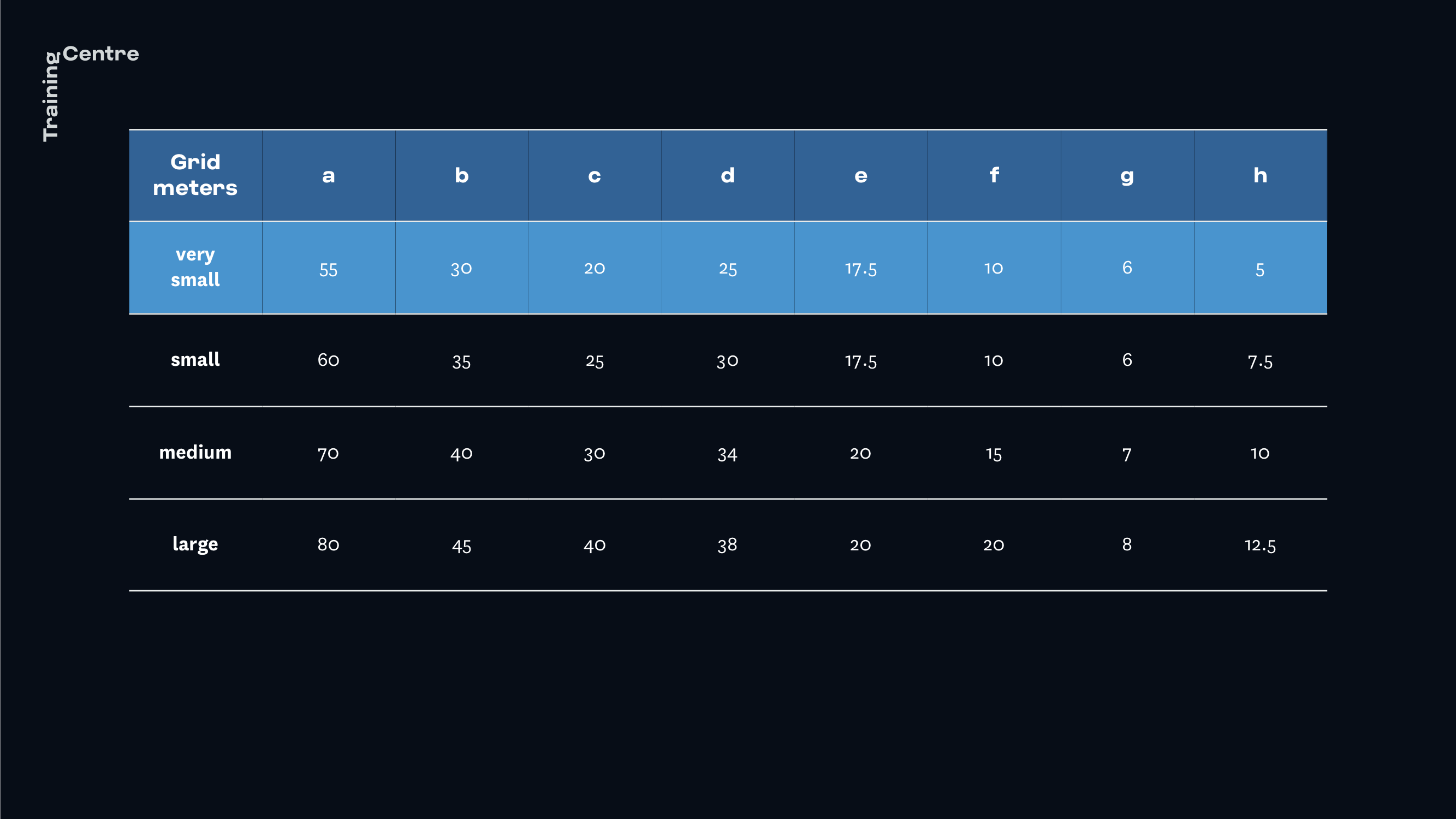
Drill duration
NB: for drills that require 2 sets, each set should be performed for half of the maximum stated duration.
- 5 players (10 players with 2 balls): 4-5 minutes ball rolling time
- 6 players (12 players with 2 balls): 5-6 minutes ball rolling time
- 7 players (14 players with 2 balls): 6-7 minutes ball rolling time
- 8 players (16 players with 2 balls): 7-8 minutes ball rolling time
Approximate workload intensity (slight variations between drills)
- 5 players (10 players with 2 balls): very high to high
- 6 players (12 players with 2 balls): high to medium
- 7 players (14 players with 2 balls): medium to low
- 8 players (16 players with 2 balls): low
Coaching points that apply to all drills
- Give players 1-2 minutes to find their tempo and familiarise themselves with the scenario, before gradually raising the tempo and intensity.
- Devote a period of time (minimum of 4 minutes) during each drill to focus on high tempo, correct technique, technical balance (two footedness) and the reinforcement of awareness habits. Where a drill requires 2 sets, ensure that a total of at least 4 minutes are devoted to these elements.
- The drill duration relates to ball rolling time. Stop the watch if the drill is interrupted for more than a few seconds.
- Encourage players to move quickly between positions. This is particularly relevant when there are few players involved in the drill, e.g. 5 6 players with 1 ball or 10-12 players with 2 balls.
- Drill 1 (1 ball) involves full left and right movement rotations. However, a second set is required for technical balance, with all players occupying starting positions on the opposite side of the playing area to the first set.
- Place the emphasis on playing a quality pass into the path of the next player in the sequence.
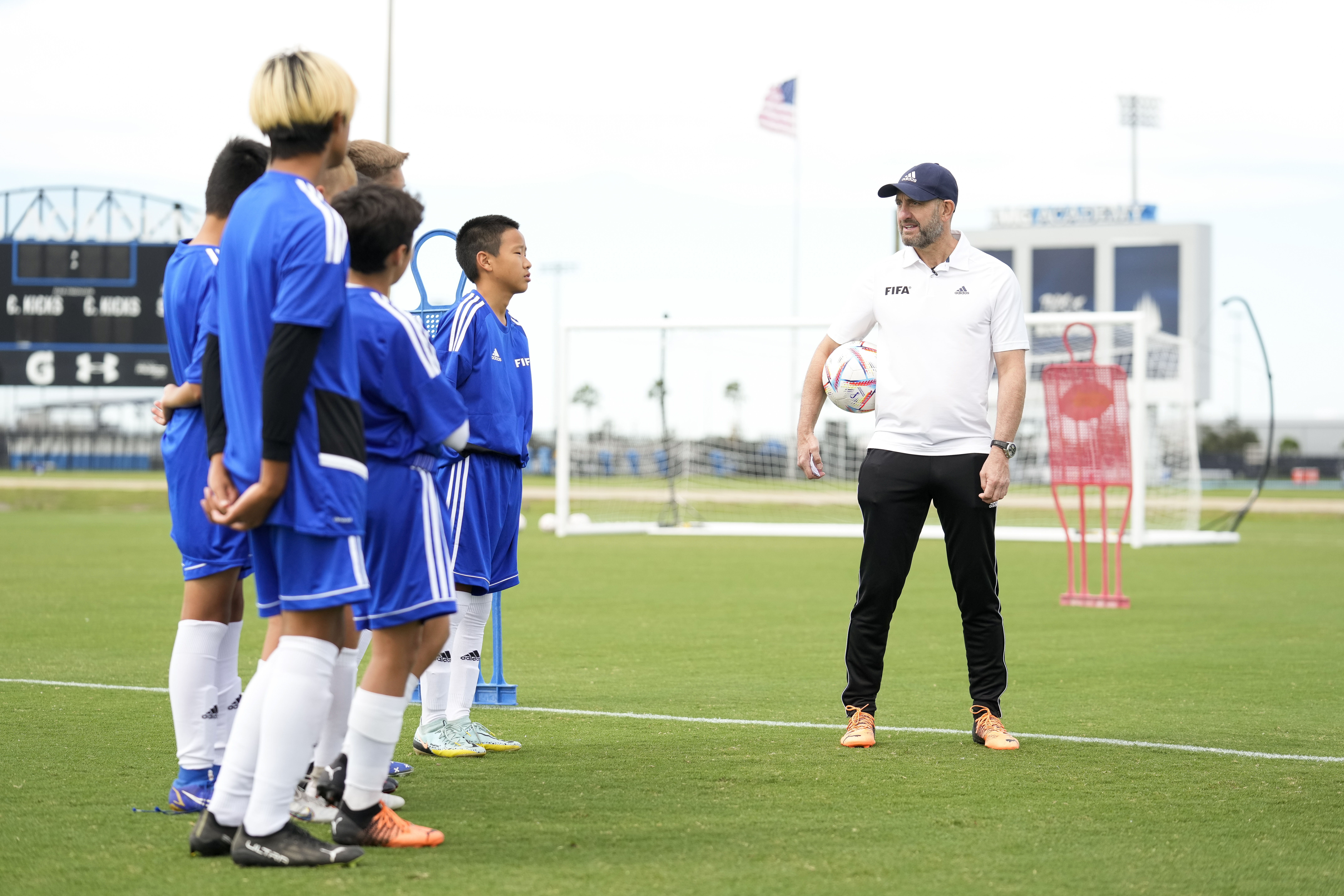
- Players should play with their heads up, scanning the area they are receiving the pass from and the intended destination of their pass.
- When performing the drills with 5 players, a coach/server is required at the starting positions at both ends of the grid to play the first pass in each rotation. When 6 (7 or 8 for drills 3 and 4) players are involved, a coach/server is required to permanently occupy one of the starting positions.
- To ensure continuous, uninterrupted ball rotation, a minimum of 20 balls is required (10 at each starting position).
- Where a session involves a particular focus on player positioning, the drills offer the flexibility to allow players to remain in the same position, i.e. defenders and midfielders can play passes 2 and 3, with attacking midfielders and forwards making the runs that offer them exposure to the sprint/HSR zones. However, this will result in large disparities in speed metrics and intensity levels between individual players. In addition, it will also pose a challenge for the coach in terms of ensuring that the sprint/HSR workloads are well distributed amongst the players. Rotating players between positions represents the most effective means to achieving a high volume speed metric outcome for all players.
Drill 1: short infield acceleration, one-two with central player, before playing the infield runner in behind on goal
-
A plays a vertical pass towards B’s infield acceleration path.
-
B makes a darting infield run to latch on to the ball before playing a short one-two with C and moving infield to receive the angled return pass. B then slots a vertical in-behind ball beyond the last line of yellow and red mannequins into D’s running path.
-
D accelerates from behind the wide blue mannequin, darting inside the red mannequin to connect with the ball to finish on goal.
-
The sequence repeats from the opposite end.
-
With 2 balls in rotation, the first passes are played simultaneously by A and A’ at opposite ends of the grid.
-
Every player follows their pass to ensure player rotation.
-
A becomes B.
-
B becomes C.
- C becomes D.
-
D becomes A’.
-
Place the emphasis on playing a quality pass into the path of the next player in the sequence.
-
This drill promotes technical balance, requiring the use of the left and right foot in equal measure.
-
B should scan infield to time their acceleration to A’s pass.
-
To promote technical balance, when playing the left-angled vertical pass for D, B should be encouraged to use their left foot to slot the ball into D’s accelerating path. The opposite applies for the vertical pass angled to the right, with the emphasis placed on right foot passing.
-
To reinforce good footballing awareness habits, D should scan infield to time their high-speed acceleration to the movement and passing interaction between B and C.
-
D: each individual acceleration should cover a distance of approximately 20m in the sprint/HSR zones.
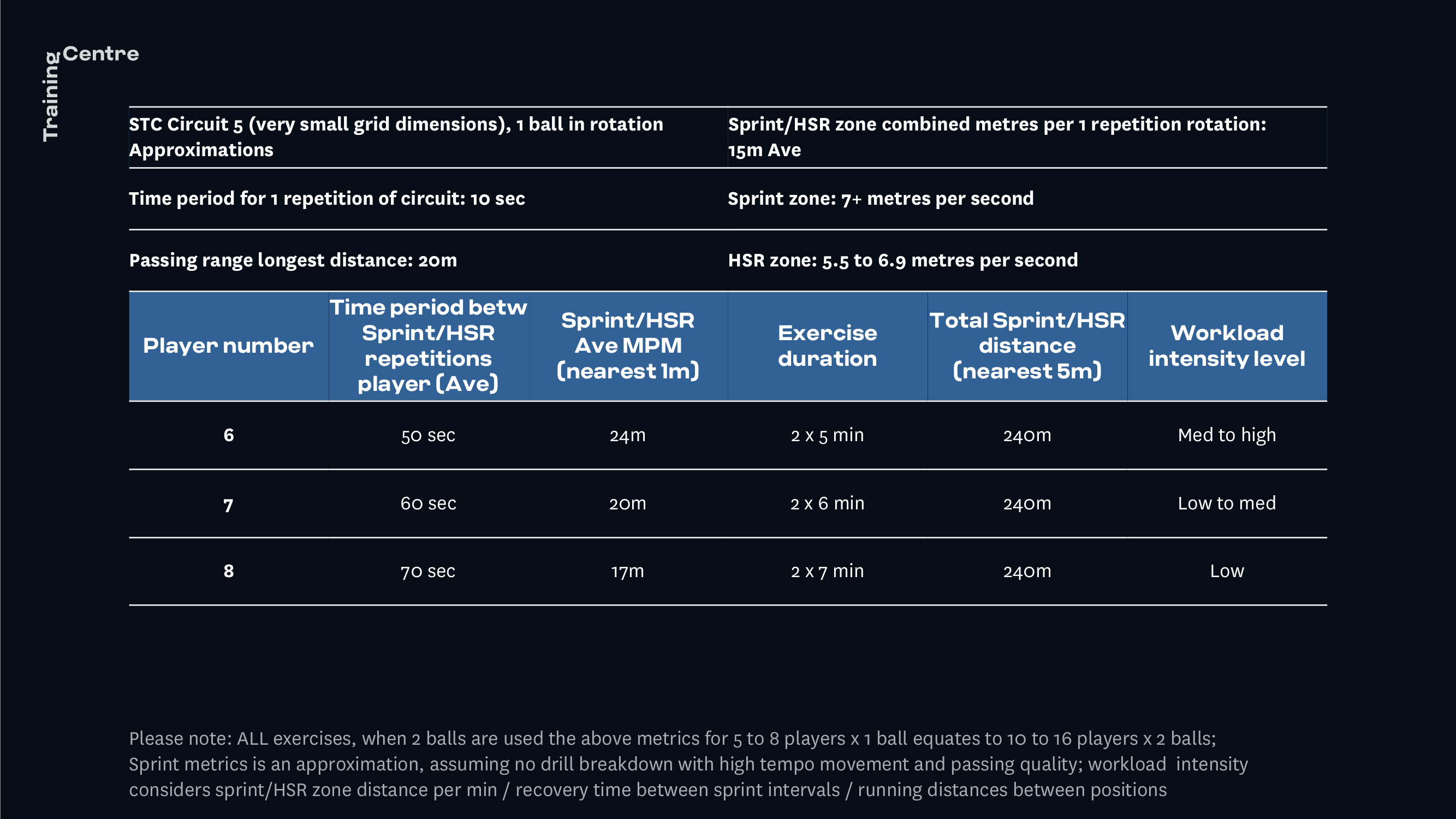
Drill 2: ball played from out wide into the space in behind for the central runner to bear down on the keeper
-
A plays a diagonal pass out wide to B.
-
B moves quickly wide of the red mannequin, shifting the ball into the forward space on their first touch to play a diagonal pass into C’s central acceleration path.
-
C drops 5m from the midline, then, in coordination with B’s pass, bursts beyond it to connect with the ball and homes in on goal to finish within three touches.
-
The sequence repeats from the opposite end.
-
With 2 balls in rotation, the first passes are played simultaneously by A and A’ at opposite ends of the grid.
-
Every player follows their pass to ensure player rotation.
-
A becomes B.
-
B becomes C.
-
C becomes A'.
-
Place the emphasis on playing a quality pass into the path of the next player in the sequence.
-
This drill promotes technical balance, requiring the use of the left and right foot in equal measure.
-
To reinforce good footballing awareness habits, B should scan across to C before playing the ball to them.
-
To promote technical balance, when playing from the left side, B should be encouraged to let the ball run to their left foot, shift it beyond the mannequin and play a left-footed pass into the space behind the midline for C. The opposite applies when playing from the right side, with the emphasis placed on right footed passes.
-
C should scan infield to time their burst into space to B’s movement and touch.
-
C: each individual acceleration should cover a distance of approximately 15m in the sprint/HSR zones.
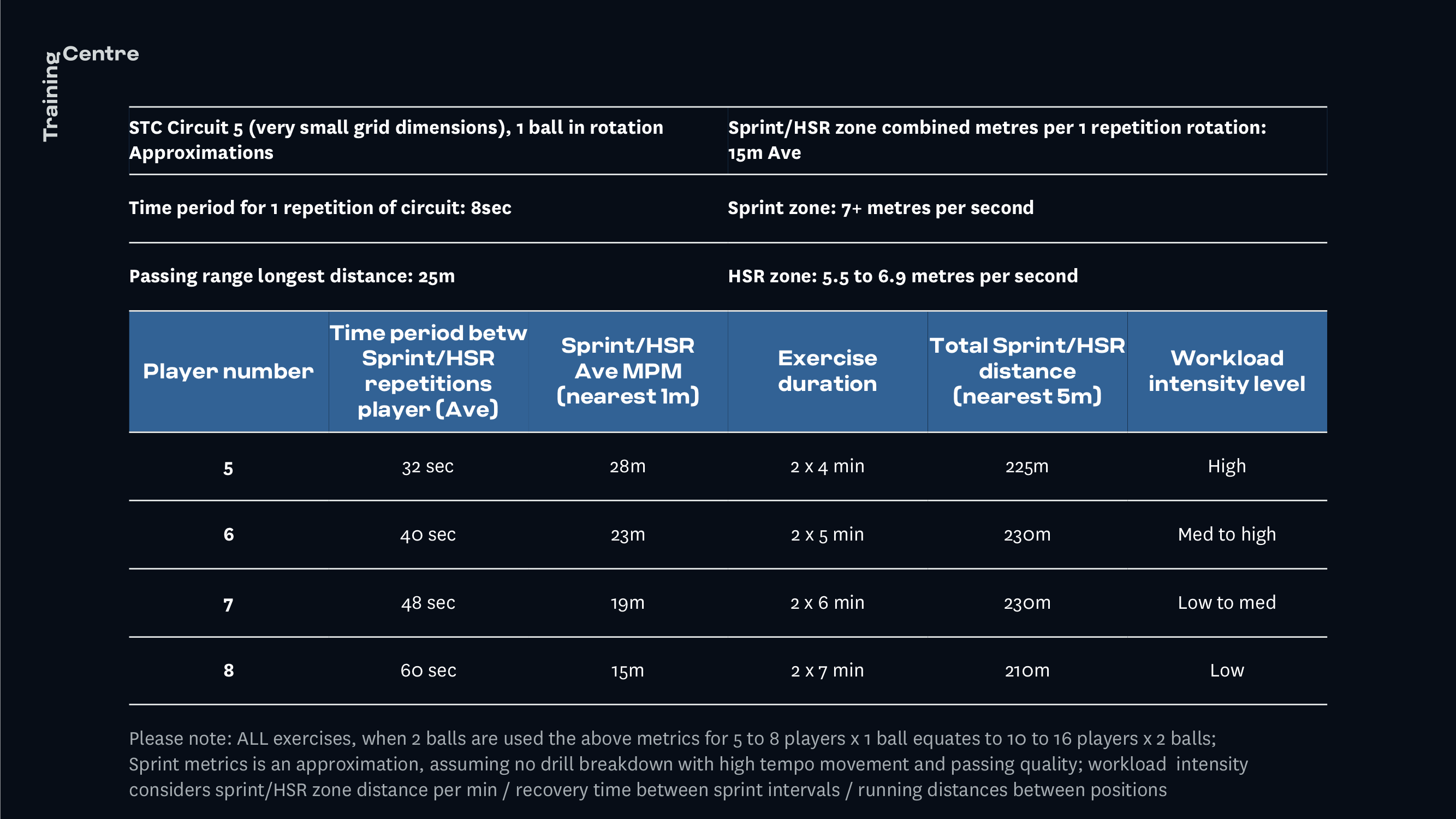
Drill 3: in-behind runner plays cross field ball to player arriving late on goal at speed
-
A plays a vertical pass angled to wide of the mannequin gate for B.
-
B moves quickly wide of the gate to receive the ball, shifting it forward on their first touch to play a long diagonal pass angled into C’s acceleration path.
-
C makes a long, high-speed run from a deep position out wide in time with A and B’s passing coordination. Latching on to the ball, C shifts it beyond the end line of mannequins and plays a cross field ball in to D.
-
D accelerates infield from the opposite wide mannequin to connect with the ball and finish first time.
-
The sequence repeats from the opposite end.
-
With 2 balls in rotation, the first passes are played simultaneously by A and A’ at opposite ends of the grid.
-
Every player follows their pass to ensure player rotation.
-
A becomes B.
-
B becomes C.
-
C becomes D.
-
D becomes A'.
-
Place the emphasis on playing a quality pass into the path of the next player in the sequence.
-
This drill promotes technical balance, requiring the use of the left and right foot in equal measure.
-
To reinforce good footballing awareness habits, B should scan towards C before receiving the ball from A.
-
B should receive the ball half turned forward while simultaneously lifting their head up before playing the long diagonal pass to C.
-
To promote technical balance, from either end of the circuit, B should be encouraged to use both their left and right foot to play the long diagonal pass. B should use the appropriate foot at all times to increase the efficiency of the sequence.
-
To reinforce good footballing awareness habits, C should scan back towards B to coordinate their run with B’s pass.
-
To promote technical balance, when playing the left-to-right cross-field pass, C should be encouraged to use their left foot. The opposite applies for the right-to-left cross-field pass to D, with the emphasis placed on right foot passing.
-
To reinforce good footballing awareness habits, D should scan across to C to time their infield acceleration to meet C’s pass with a view to meeting the ball late.
-
To promote technical balance, D should be encouraged to use both their left and right foot to finish on goal.
-
C and D: should cover a combined distance of approximately 40m in the sprint/HSR zones.
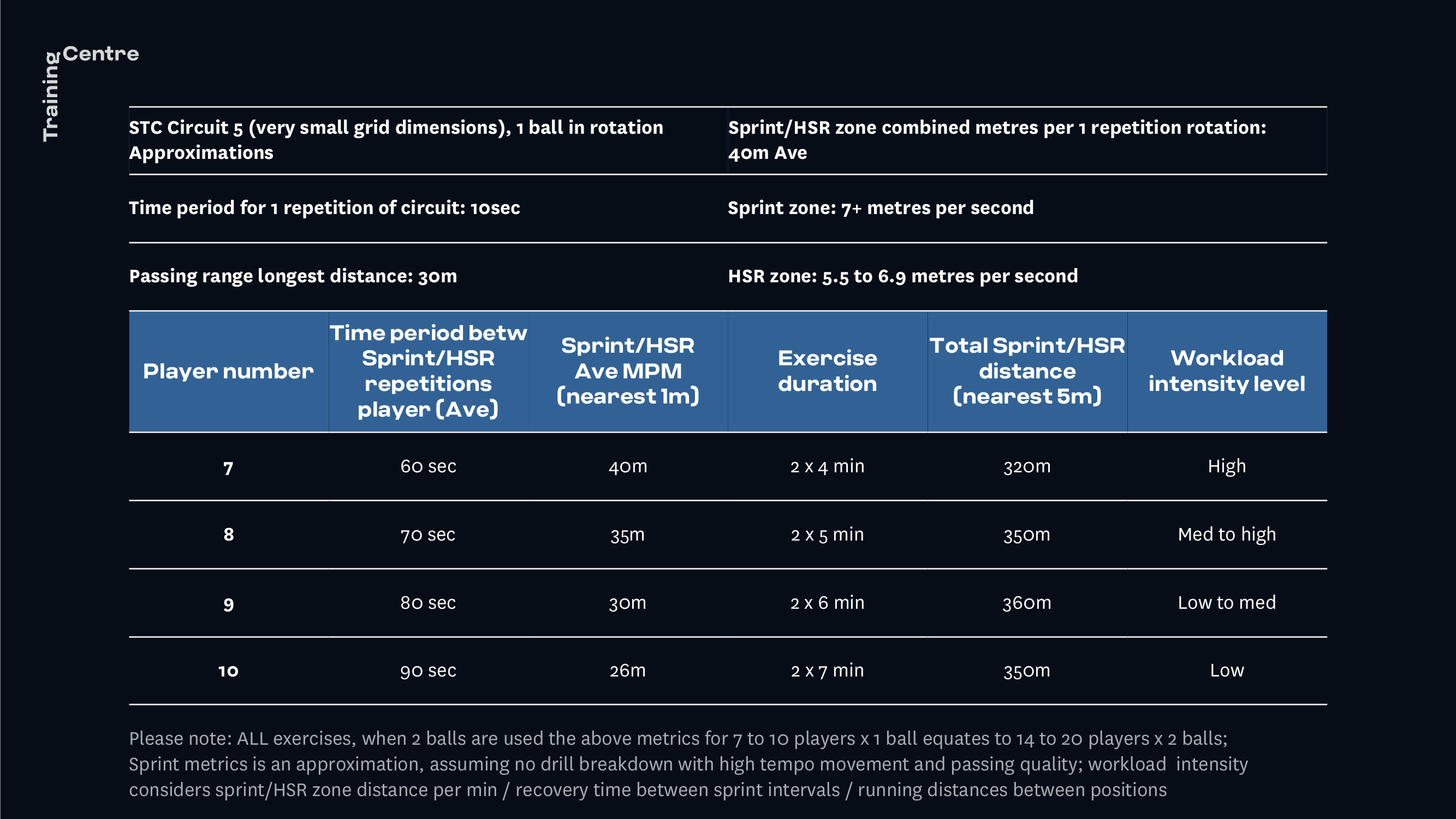
Drill 4: four-player combination featuring a give inside and go behind before crossing the ball to the far post
-
A plays a diagonal pass out wide into B’s forward movement.
-
Meeting the ball beyond the corner mannequin, B plays a give-and-go with C consisting of a diagonal pass infield, followed by a high-speed run to chase down the return ball.
-
Latching on to the ball, B plays a cross field pass to meet D’s run from the opposite side of the pitch.
-
After making a diagonal run inside, D connects with the ball to finish first time on goal.
-
The sequence repeats from the opposite end.
-
With 2 balls in rotation, the first passes are played simultaneously by A and A’ at opposite ends of the grid.
-
Every player follows their pass to ensure player rotation.
-
A becomes B.
-
B becomes C.
-
C becomes D.
- D becomes A'.
-
When 7 or 8 players are involved in the drill with one ball or 12 or 13 players with two balls, coaches/servers are required to permanently occupy either one or both of the A/A’ starting positions.
-
Place the emphasis on playing a quality pass into the path of the next player in the sequence.
-
This drill promotes technical balance, requiring the use of the left and right foot in equal measure.
-
B should scan across towards A to time their forward movement in coordination with A’s pass.
-
To promote technical balance, when playing the left-to-right cross-field pass, B should be encouraged to use their left foot. The opposite applies for the right-to-left cross-field pass to D, with the emphasis placed on right-foot passing.
-
B and D should cover a combined distance of approximately 45m in the sprint/HSR zones.
